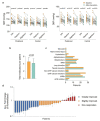Compliance to Multidisciplinary Lifestyle Intervention Decreases Blood Pressure in Patients with Resistant Hypertension: A Cross-Sectional Pilot Study
- PMID: 36675608
- PMCID: PMC9867179
- DOI: 10.3390/jcm12020679
Compliance to Multidisciplinary Lifestyle Intervention Decreases Blood Pressure in Patients with Resistant Hypertension: A Cross-Sectional Pilot Study
Abstract
Hypertension is a common chronic medical condition. Treatment is not satisfactory in a significant proportion of patients with primary hypertension, despite the concurrent use of three or more medications with different mechanisms of action. Such treatment-resistant hypertension is a clinical challenge associated with poor prognosis and needs further investigation. The efficacy of lifestyle changes has not been established yet in patients with resistant hypertension, and educational efforts appear clinically irrelevant in patients who must achieve behavioral changes without supervision. A 6-month multidisciplinary pilot intervention enrolled 50 patients with established resistant hypertension. The aims were: (1) to examine whether intensive and supervised lifestyle changes contribute to decreasing blood pressure in this condition, and (2) to identify which components affect compliance and feasibility. The program provided intensive changes in nutrition, physical exercise, and control of sleep disturbances supervised by nutritionists, physiotherapists, and psychologists. Nurses and pharmacists followed up on adherence to the antihypertensive medication. The primary outcome was 24 h blood pressure control. Data in patients with full compliance (n = 30) indicate that lifestyle modifications in resistant hypertension significantly reduced 24 h both systolic and diastolic blood pressure (p < 0.01), body mass index (p < 0.01), medication burden (p = 0.04), improving physical fitness, and cardiovascular risk markers such as heart rate (p = 0.01) and augmentation index (p = 0.02). The adherence to the intervention was moderate, with an attrition rate of 12%. A modified version reducing visits and explorations will likely improve compliance and can be used to assess the long-term maintenance of these benefits in managing resistant hypertension by diverse healthcare providers.
Keywords: hypertension; therapeutics; weight management.
Conflict of interest statement
The authors declare no conflict of interest.
Figures



References
-
- Zhou B., Carrillo-Larco R.M., Danaei G., Riley L.M., Paciorek C.J., Stevens G.A., Gregg E.W., Bennett J.E., Solomon B., Singleton R.K., et al. Worldwide Trends in Hypertension Prevalence and Progress in Treatment and Control from 1990 to 2019: A Pooled Analysis of 1201 Population-Representative Studies with 104 Million Participants. Lancet. 2021;398:957–980. doi: 10.1016/S0140-6736(21)01330-1. - DOI - PMC - PubMed
-
- Carey R.M., Calhoun D.A., Bakris G.L., Brook R.D., Daugherty S.L., Dennison-Himmelfarb C.R., Egan B.M., Flack J.M., Gidding S.S., Judd E., et al. Resistant Hypertension: Detection, Evaluation, and Management: A Scientific Statement From the American Heart Association. Hypertension. 2018;72:e53–e90. doi: 10.1161/HYP.0000000000000084. - DOI - PMC - PubMed
LinkOut - more resources
Full Text Sources

